Physicist: Magnetic fields are nothing more than the result of combining an electric field with the effects of relativity.
First some background. Magnetic fields were first defined in such a way that iron filings will point in the direction of (what became defined as) the field. The reason why filings point in the direction of the field is a little round about, but luckily the physics turned out pretty clean.
Classical physics: A when a charge moves in some direction it creates a magnetic field that wraps around it. The direction of the field can be found using (one of) the “right hand rule(s)”.
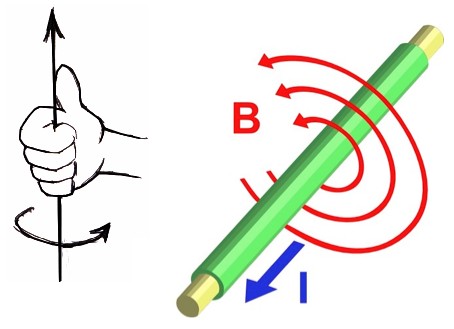
When a charge moves it's called "current". A current (even a single moving charge) produces a field that wraps around it's direction of motion according to a right hand rule: point your right thumb along the current, and your fingers will curl in the direction of the field. The greater the charge or speed, the greater the field. Physicists, being clever, generally label the magnetic field as "B" and current as "I".
In addition to creating magnetic fields, moving charges also experience force from a magnetic field that can be found using another right hand rule. Point your fingers (on your right hand, of course) in the direction the charge is moving, curl your fingers in the direction of the field, and your thumb will be pointing in the direction of the force.
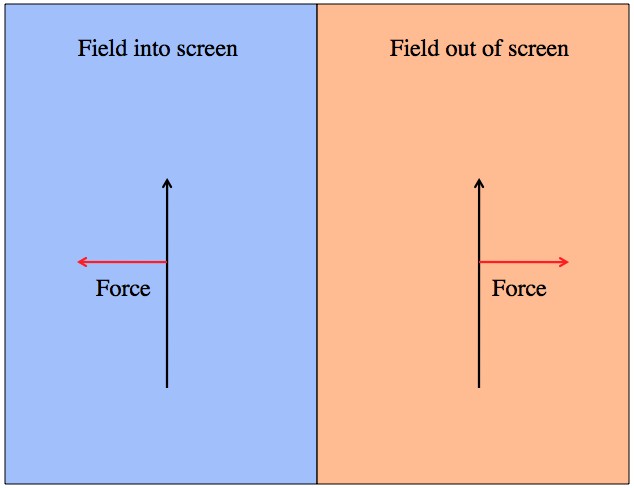
The charge is moving up. When the magnetic field points into your computer screen, the charge will feel a force pushing left. When the magnetic field points out of your screen the charge is pushed to the right.
By carefully twisting your hand about you should be able to figure out that two like charges, traveling side by side in the same direction, will experience a magnetic attraction. Of course, likes repel (and opposites attract) so the two charges will feel an electric force repulsion. This electric repulsion is always greater than the magnetic attraction, so the particles still fly apart, just slower.
The exception is things like electrical wires. There’s an equal amount of positive and negative charge in the wires, so the magnetic force is all that’s left.
But this all begs the question; how fast do the particles have to be moving so that the magnetic field they generate to pull them together is strong enough to balance the electric force pushing them apart? The answer is exactly the speed of light (not a coincidence).
Also, if wires with current in them experience magnetic forces, but not electric forces, doesn’t that make magnetic fields “real”? Not quite.
Relativistic physics: Consider the two particles flying along. If you’re moving with them, then they’re sitting still from you’re point of view, and they just fly apart (stationary charges don’t generate a magnetic field). But (classically) if the charges are moving past you they generate a magnetic field, and that keeps them from flying apart quite as fast.
However, if you write down how much time dilation the charges will experience from moving past you, the slowness of their separation is explained away. The “magnetic field” is just an illusion created by the slowing of time.
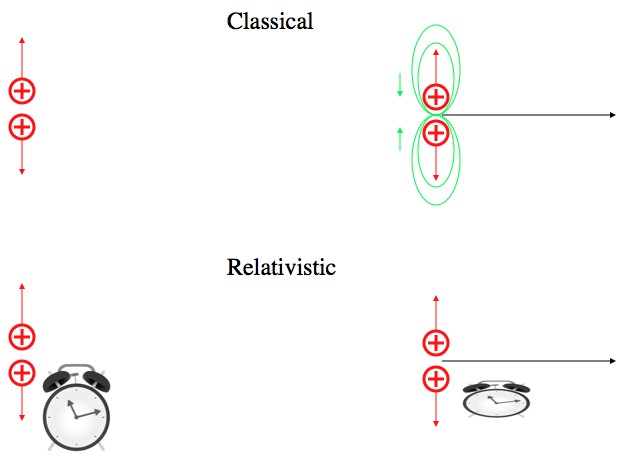
Classically, two charges moving in the same direction will fly apart slower than normal because of their magnetic field. Relativity shows that this effect is more correctly explained using time dilation: they move through time slower, so they fly apart slower.
From this point of view it makes perfect sense that in order to arrest the repulsion of the two charges, they would need to be moving at the speed of light. Like charges repel, period. So, in order to not fly apart, they must not experience any time at all (no time passes at light speed).
Now consider two parallel, current carrying wires. When current is flowing electrons (negative charge) are moving through the wire, and the protons (positive charge) in the nuclei of the atoms stay where they are. The protons see the protons in the other wire normally, but since the electrons in the other wire are moving, the protons see the electrons as closer together because of a relativistic effect called “length contraction“. The electrons, in turn, see the protons as moving and so experience the same effect. The end result is that every particle in both wires sees the other wire as have an opposite net charge.
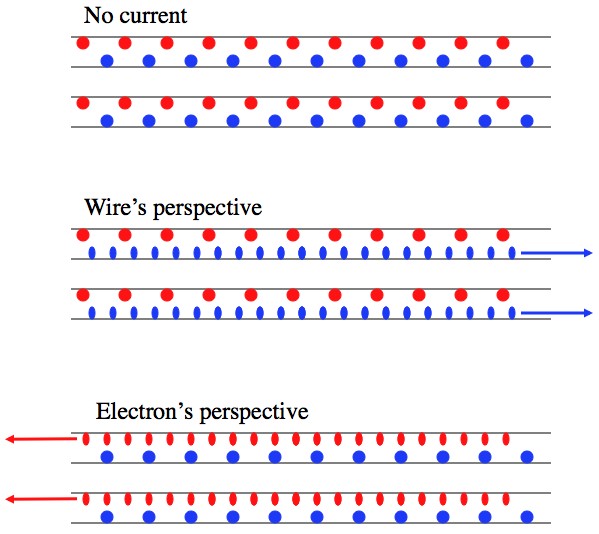
The protons in both wires see the electrons in both wires as denser due to length contraction. So they're happy in their own wire and also try to attract the other wire. The electrons experience the same thing. If the current in the wires run in opposite directions, then (for the same reasons) the wires repel each other.
So if magnetic fields are just weird relativistic effects, then where do magnetic poles, bar magnets, and whatnot come from?
So far we’ve got that current flowing in the same direction down two wires makes those wires attract, and current flowing in opposite directions makes them repel. To get the magnets of your childhood (some of our childhoods) all you have to do is turn that wire into a loop.
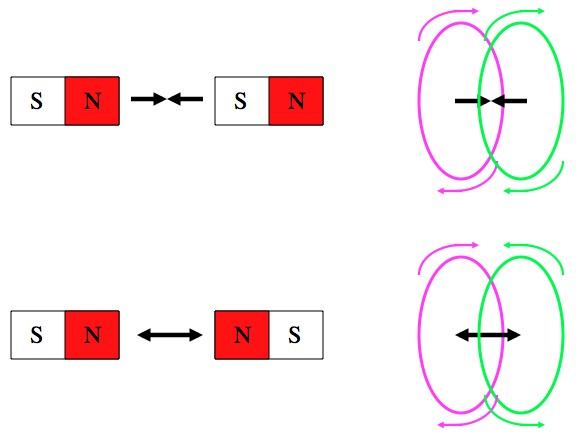
A loop of wire behaves like a bar magnet. When two are oriented the same way they attract, and when oriented oppositely they repel.
This perspective, that all magnetic dipoles (bar magnets, big and small) are reducible to current loops, helps explain a lot of things; like why there are no magnetic monopoles, and why atoms generate magnetic fields (an orbiting electron is essentially a current loop).
The more common view of the magnetic field (among physicists) is that it is merely part of a larger structure called an “electromagnetic field”. Funny story: when Einstein first wrote his big-shit paper about relativity the whole “time and space” thing was more of a side note. What he was really interested in was combining the electric and magnetic forces under one roof. In a nutshell, if a charge is moving through space in the presence of a magnetic field, it feels a push in a new direction dictated by the right hand rule (above). If a charge is moving through time, in the presence of an electric field it also feels a push in a new direction (generally to or away from another charge). So electric fields work on charges moving through time, and magnetic fields work on charges moving through space. Special relativity shows that the distinction between time and space are academic (Without batting an eye a physicist will say things like “north and east and future are three orthogonal directions”). So the electromagnetic field is just a more compact way of dealing with the two fields all at once.
Personally, I find that when you consider the source of a magnetic field (moving charges), combining relativity with the Coulomb force explains everything you need. Albeit, not very clearly, or succinctly. The rules about conservation of magnetic field lines, for example, fall out of conservation of charge and momentum. But most people would rather just work with the (illusionary) magnetic field lines than go back to basics every five minutes. And why not? It makes the math much easier.

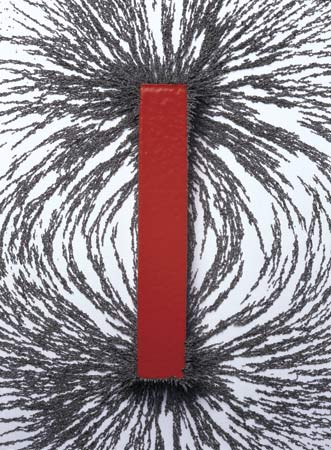






Pingback: QFT für alle: Relativistische Tricksereien [Hier wohnen Drachen] | Hirnspunk
Pingback: QFT für alle: Relativistische Tricksereien – Hier wohnen Drachen
Pingback: Personalidad magnética | Tópicos Químicos
Pingback: Magnet painting art | IDEA Studio 2 | Creative Robotics
Pingback: Magnet painting art – FINAL DOCUMENTATION | IDEA Studio 2 | Creative Robotics